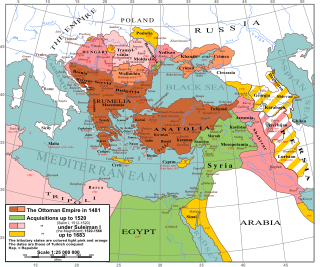Related Research Articles
Battle, capture, fall, or siege of Baghdad may refer to:

The administrative divisions of the Ottoman Empire were administrative divisions of the state organisation of the Ottoman Empire. Outside this system were various types of vassal and tributary states.

Eyalets, also known as beylerbeyliks or pashaliks, were the primary administrative divisions of the Ottoman Empire.

Beylerbey was a high rank in the western Islamic world in the late Middle Ages and early modern period, from the Anatolian Seljuks and the Ilkhanids to Safavid Empire and the Ottoman Empire. Initially designating a commander-in-chief, it eventually came to be held by senior provincial governors. In Ottoman usage, where the rank survived the longest, it designated the governors-general of some of the largest and most important provinces, although in later centuries it became devalued into a mere honorific title. The title is originally Turkic and its equivalents in Arabic were amir al-umara, and in Persian, mir-i miran.

The Aq Qoyunlu or the White Sheep Turkomans was a culturally Persianate, Sunni Turkoman tribal confederation. Founded in the Diyarbakir region by Qara Yuluk Uthman Beg, they ruled parts of present-day eastern Turkey from 1378 to 1503, and in their last decades also ruled Armenia, Azerbaijan, much of Iran, Iraq, and Oman where the ruler of Hormuz recognised Aq Qoyunlu suzerainty. The Aq Qoyunlu empire reached its zenith under Uzun Hasan.

Wāli, Wā'lī or vali is an administrative title that was used in the Muslim world to designate governors of administrative divisions. It is still in use in some countries influenced by Arab or Muslim culture. The division that a Wāli governs is called Wilayah, or Vilayet.
The term Turco-Persian wars can refer to two sets of conflicts between Turkic states and Persian states:

The siege of Esztergom occurred between 25 July and 10 August 1543, when the Ottoman army, led by Sultan Suleiman the Magnificent, besieged the city of Esztergom in modern Hungary. The city was captured by the Ottomans after two weeks.
Sultanzade Şemsi Ahmed Pasha, known simply as Şemsi Pasha, was a distinguished Ottoman nobleman and beylerbey who occupied several high-ranking posts, serving at various stages as the Ottoman governor-general of the beylerbeyliks of Damascus, Anatolia and Rumeli.

The Eyalet of Kefe or Caffa was an eyalet of the Ottoman Empire. The eyalet stretched across the northern coast of the Black Sea with the main sanjak being located in the southern coast of Crimea. The eyalet was under direct Ottoman rule, completely separate from the Khanate of Crimea. Its capital was at Kefe, the Turkish name for Caffa.

The Eyalet of Rumeli, or Eyalet ofRumelia, known as the Beylerbeylik of Rumeli until 1591, was a first-level province of the Ottoman Empire encompassing most of the Balkans ("Rumelia"). For most of its history, it was the largest and most important province of the Empire, containing key cities such as Edirne, Yanina (Ioannina), Sofia, Filibe (Plovdiv), Manastır/Monastir (Bitola), Üsküp (Skopje), and the major seaport of Selânik/Salonica (Thessaloniki). It was also among the oldest Ottoman eyalets, lasting more than 500 years with several territorial restructurings over the long course of its existence.

Lala Mustafa Pasha's Caucasian campaign was a military expedition launched in 1578 by Lala Mustafa Pasha, a grand-vizier of the expanding Ottoman Empire. It is also considered a part of the larger conflict, Ottoman–Safavid War (1578–90).
Afshar Beylik was a Turkoman beylik (principality) in Eastern Anatolia in the early 16th century. It was founded by the Afshar tribe which was an Oghuz Turkic tribe with Shia Muslim faith. The Afshar Beylik was the last of the Anatolian beyliks to be incorporated into the Ottoman Empire in 1534 during the Ottoman campaign.

Şah Sultan was an Ottoman princess, daughter of Sultan Selim I and one of his concubines. She was the half-sister of Sultan Suleiman the Magnificent.
Imperialism in Asia may refer to:
In the Safavid Empire, a beylerbeylik was a large administrative entity. Each beylerbeylik was governed by a beylerbey. The term was also used in the Ottoman Empire.

The Battle of Turnadağ was an engagement between the forces of the Ottoman Empire and the Beylik of Dulkadir of Turkey in 1515.

Selim I, known as Selim the Grim or Selim the Resolute, was the sultan of the Ottoman Empire from 1512 to 1520. Despite lasting only eight years, his reign is notable for the enormous expansion of the Empire, particularly his conquest between 1516 and 1517 of the entire Mamluk Sultanate of Egypt, which included all of the Levant, Hejaz, Tihamah and Egypt itself. On the eve of his death in 1520, the Ottoman Empire spanned about 3.4 million km2 (1.3 million sq mi), having grown by seventy percent during Selim's reign.
Şehzade Murad was an Ottoman prince (şehzade), a son of Şehzade Ahmed and a grandson of Sultan Bayezid II. He was involved in the chaos that surrounded the succession to Sultan Bayezid II.
The Pinyanişi principality, was a Kurdish principality established in 1548 in the Salmas and Somay regions.